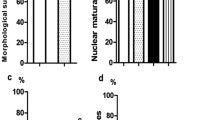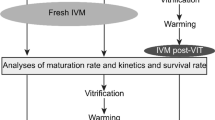Abstract
Purpose: The purpose of this study was to determine the developmental ability and ultrastructure of MII mouse oocytes after cryopreservation by slow freezing or vitrification.
Methods: Ovulated MII mouse oocytes were allocated to slow frozen, vitrified and control groups. Oocytes in the slow frozen and vitrified groups were cryopreserved using 1,2 propandiol (PROH) and ethylene glycol (EG) respectively as cryoprotectants. After thawing, the surviving MII oocytes in both cryopreserved groups and the control group were inseminated and their developmental ability was compared. The ultrastructure of MII oocytes in both cryopreserved groups was assessed immediately after thawing and 10 h post insemination at the pronuclear stage, and compared with that of the control group.
Results: The survival rates were nearly identical in both cryopreserved groups. The fertilization rates were also identical and comparable to that of the control group. The further development of vitrified oocytes was similar to that of the control oocytes, whereas it was severely limited in the slow-frozen oocytes. In the slow-frozen MII oocytes, the intermediate filaments were destroyed and the oolemma and microvilli were also modified. At the pronuclear stage deterioration of mitochondria and the presence of numerous vacuoles were also observed within the ooplasm. In the vitrified MII oocytes, the intermediate filaments were the only structures affected and these cytoskeletal elements were reorganized at the pronuclear stage.
Conclusions: Vitrification results in less ultrastructural damage and better post fertilization development of MII mouse oocytes than slow freezing.
Similar content being viewed by others
References
Tsunoda Y, Parkening TA, Chang MC: In vitro fertilization of mouse and hamster eggs after freezing and thawing. Experientia 1976;32:223–224
Gook DA, Osborn SM, Johnston WIH: Cryopreservation of mouse and human oocytes using 1,2 propandiol and the configuration of the meiotic spindle. Hum Reprod 1993;8:1101–1109
Gook DA, Schiewe MC, Osborn, SM et al.: Intracytoplasmic sperm injection and embryo development of human oocytes cryopreserved using 1,2 propandiol. Hum Reprod 1995;10:2637–2641
Cohen J, DeVane GW, Elsner CW, Fehilly CB, Kort HI, Massey JB, Turner TG Jr: Cryopreservation of zygotes and early cleaved human embryos. Fertil Steril 1988;49:283–289
Murayama S, Yamano S, Kobayashi T, J Shikawa H, Kunikata K, Aono T: Successful freezing of unfertilized mouse oocytes and effect of cocultures in oviducts on development of in vitro fertilized embryos after thawing. J Assist Reprod Genet 1994;11:156–161
Joly C, Bchini O, Boulekbach H, Testart J, Maro B: Effects of 1,2 propandiol on the cytoskeletal organization of the mouse oocyte. Hum Reprod 1992;7:374–378
Imoedmbe D, Gx Sigue AB: Survival of human oocytes cryo-preserved with or without the cumulus in 1,2-propandiol. J Assist Reprod Genet 1992;9:323–327
Shaw PW, Bernard A, Fuller BJ, Hunter JE, Shaw RW: Vitrification of mouse oocytes using short cryoprotectant exposure: Effects of varying exposure time on survival. Mol Reprod Dev 1992;33:210–214
Wood MJ, Barros C, Candy CJ, Carroll J, Melendez J, Whittingham DG: High rates of survival and fertilization of mouse and hamster oocytes after vitrification in dimethyl sulfoxide. Biol Reprod 1993;49:489–495
O’Neil L, Pagnter SJ, Fuller BJ, Shaw RW: Vitrification of mature mouse oocytes: Improve results following addition of polyethylene glycol to a dimethyl sulfoxide solution. Cryobiology 1997;34:295–301
Liebermann J, Nawroth F, Isachenko V, Isacheko E, Rahimi G: Potential importance of vitrification in reproductive medicine. Biol Reprod 2002;67:1671–1680
Rayos AA, Takahashi Y, Hishinuma M, Kanagawa H: Quick freezing of unfertilized mouse oocytes using ethylene glycol with sucrose or trehalose. J Reprod Fertil 1994;100:123–129
Hotamisligil S, Toner M, Powers RD: Changes in membrane integrity, cytoskeltal structure, and developmental potential of murine oocytes after vitrification in ethylene glycol. Biol Reprod 1996;55:161–168
Chen SU, Lien YR, Chao KH, Lu HF, Ho HN, Yang YS: Cryopreservation of mature human oocytes by vitrification with ethylene glycol in straws. Fertil Steril 2000;74:804–808
Johnson MH, Pickering SJ, George MA: The influence of colling on the properties of the zona pellucida of the mouse oocyte. Hum Reprod 1988;9:383–387
Vincent C, Pickering SJ, Johnson MH, Quick SJ: Dimethyl sulphoxide affects the organization of microfilaments in the mouse oocyte. Mol Reprod Dev 1990;26:227–235
Pickering SJ, Braude PR, Johnson MH: Cryopreservation of human oocyte: In appropriate exposure to DMSO reduces fertilization rates. Hum Reprod 1991;6:142–143
Petit VA, Edidin M: Lateral phase separation of lipids in plasma nembranes: Effect of temperature on the mobility of membrane antigens. Science 1984;184:1183
Pickering SJ, Braude PR, Johnson MH, Cant A, Currie J: Transient cooling to room temperature can cause irreversible disruption of the meiotic spindle in the human oocyte. Fertil Steril 1990;54:102–108
Vincent C, Pickering SJ, Johnson MH: The hardening effect of dimethyl sulphoxide on the mouse zoan pellucida requires the presence of an oocyte and is associated with a reduction in the number of cortical granules present. J Reprod Fertil 1990;89:253–259
Carroll J, Depypere H, Matthews CD: Freeze-thaw-induced changes of the zona pellucida explains decreased rates of fertilization in frozen-thawed mouse ooctyes. J Reprod Fertil 1990;90:547–553
Sathananthan AH, Trounson A, Freeman L: Morphology and fertilizability of frozen human oocytes. Gamete Res 1987;16:343–334
Zhao J, Hattori M, Fujihara N: Ultrastructural comparison between immature and in vitro matured bovine oocytes cryopreserved in propandiol. J Mamm Ova Res 1997;14:84–94
Sathananthan AH, Trounson A, Freeman L, Brady T: The effects of cooling human oocytes. Hum Reprod 1988;3:968–977
Hochi S, Kozawa M, Fujimoto T, Hondo E, Yamada J, Oguri N: In vitro maturation and transmission electron microscopic observation of horse oocytes after vitrification. Cryobiology 1996;33:300–310
Fuku E, Xia L, Downej BR: Ultrastructural changes in bovine oocytes cryopreserved by vitrification. Cryobiology 1995;32:139–56
AL Hasani S, Diedrich K, Van der Ven H, Reinecke A, Hartje M, Krebs D: Cryopreservation of human oocytes. Hum Reprod 1987;2:656–700
Pedro PB, Sakurai T, Edashige K, Kasai M: Effects of osmotic shrinkage on the survival of mouse oocytes and embryos at various developmental stage. J Mamm Ova Res 1997;14:66–71
Kasai M, Komi JH, Takakamo A, Tsudera H, Sakurai T, Machida T: A simple method for mouse embryo cryopreservation in a low toxicity vitrification solution, without appreciable loss of viability. J Reprod Fertil 1990;89:91–97
Chen C: Pregnancy after human oocyte cryopreservation. Lancet 1988;ii:884–886
Dhali A, Manik RS, Das SK, Singla SK, Palta P: Post-vitrification survival and in vitro maturation rate of buffalo (Bubalus bubalis) oocytes: Effect of ethylene glycol concentration and exposure time. Anim Reprod Sci 2000;163:159–165
Miyamoto H, Ishibashi T: Survival of frozen-thawed mouse and rat embryos in the presence of ethylene glycol. J Reprod Fertil 1977;50:373–375
Schalkoff ME, Oskowitz SP, Powers PD: Ultrastructural observation of human and mouse oocytes treated with cryopreservation. Biol Reprod 1989;40:379–393
Weber K, Osborn M: The molecules of the cell matrix. Sci Am 1985;253:92–102
Author information
Authors and Affiliations
Corresponding author
Rights and permissions
About this article
Cite this article
Valojerdi, M.R., Salehnia, M. Developmental potential and ultrastructural injuries of metaphase II (MII) mouse oocytes after slow freezing or vitrification. J Assist Reprod Genet 22, 119–127 (2005). https://doi.org/10.1007/s10815-005-4876-8
Received:
Accepted:
Issue Date:
DOI: https://doi.org/10.1007/s10815-005-4876-8




